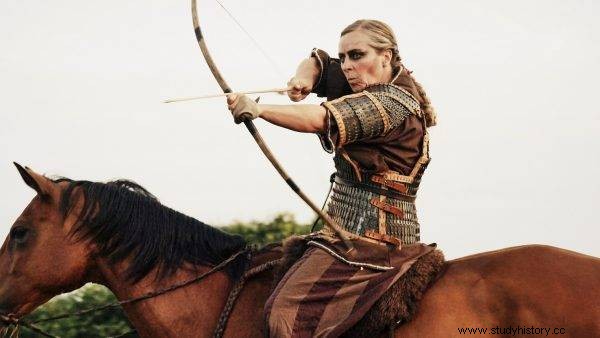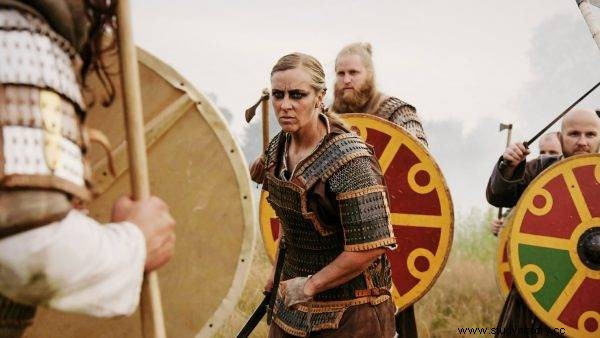Nordic sagas, legends and chronicles shape the image of women in the far North, completely different from what we know from sources relating to antiquity or the Middle Ages. Valkyries, giantesses, shield seals, fortune tellers - the fair sex played an extremely important role in Viking beliefs. Until recently, it was believed that they were only the heroines of myths. But are you sure?
While there is no doubt that the mythical valkyries or giantesses did not have their reflection in the everyday life of the Scandinavians of the Viking era, the other models of heroines sung in written sources about the far North leave room for discussion.
In Norse tales we can also find shield-bearers and fortune-tellers - influential and strong. It is such an image of women that distinguishes frosty Scandinavia from other cultures . Until recently, people looked at them with a pinch of salt - sagas or chronicles are not the most reliable sources. They were not written down until the 12th century. We can therefore expect a lot of distortions from them.
Fearless Warriors
So, did the shield bears really exist? Archaeological research has long brought to light the graves of women in whom weapons were laid. At the same time, the interpretations of these finds made it clear that it could not be the equipment of the warriors. Until then.
In 2017, researchers reinterpreted the 1878 discovery. It is the grave of Bj 581 found in Birka - one of the Viking craft and trade settlements. The grave I mentioned was found in an extremely prestigious place. The grave furnishings also testified to the high status of the person buried there.
There were many objects next to the body suggesting that a warrior was buried here:incl. iron sword, combat knife, iron spear with additional arrowheads decorated with silver and copper, metal pieces of an ax, two umba (metal reinforcements in the center of the shield), as well as stirrups, remains of the game board with pieces and many others. There was also a platform in the grave on which two horses were sacrificed. That is why, in the first interpretation, the researchers classified the find as a male burial almost without hesitation.

During the Viking Age, there were women who were professionally engaged in combat, and battles were an essential part of their lives.
In 2017, however, it was re-analyzed. The skeleton resting in the grave was again examined and a DNA test was performed. It was soon confirmed that it was a woman of about 30 years of age. Of course, this discovery did not prove unequivocally that the shieldworms really existed. Nevertheless, it made us realize that in the Viking Age there were women who were professionally engaged in combat, and battles were an essential part of their lives.
The tomb of Bj 581 also became the basis for commencing further research. More and more burials with weapons discovered years ago are starting to be looked at. The results of these works are gradually published in monographs. We will soon be able to read a broader study on Viking warriors.
Viking witches
For the Vikings, magic was mixed with life. No wonder then that völvs - women who practiced prophecy and witchcraft - held an extremely strong position . In Scandinavian society, magical art was called seiðr and was practiced by representatives of the fair sex. Seiðr had a twofold character. On the one hand, a prophetess in the ritual could foretell the future, on the other, with her practice, she could try to influence human fate.
The name of this art comes from a word translated as "thread" or "rope" and prompts researchers to closely associate it with the function of a weaver or spinner. The ritual performed by the prophetess was supposed to refer to the process of weaving.
No wonder that a woman who had an influence on the fate of the world in the minds of her contemporaries, occupied an important position in society . The existence of such women is confirmed by archaeological finds - such as those discovered in the Viking city of Fyrkat in Denmark. One of the graves found there is identified as the burial of the prophetess. She was buried in a wagon, a symbol of high status. Dressed in a long gown with elements made of real gold, she rested amid unusual gifts.
Next to it were discovered a wand, a box with the remains of a lead-based white paste (used for make-up), silver pendants in the shape of "duck legs" that certainly made noise when moving, and a chair-shaped amulet. At the woman's feet a box was placed in which there were pellets of an owl, a small bird and the bones of a mammal.
The leather pouch, in which the seeds of a highly toxic black hen had been placed, also turned out to be unusual. This plant, when burned, causes hallucinations and euphoria in humans. It is very possible that it was used during the seiðr practice.
(Un) ordinary
But in addition to warriors and seers, women in the Viking age played many other extremely important roles. They took power when men went on a war or a plundering expedition. They managed the castles, took care of food supplies, and were responsible for the defense of the castles. The proof of the status of these influential ladies is the amazing Oseberg find.
In 1904, one of the most spectacular burials in the Viking world was discovered near Tønsberg . . Two women were buried on a boat made of oak wood, 21.5 meters long and 5.1 meters wide. This burial, dating back to 834, is the richest ever found. The funerary equipment consisted of unusual items and is counted in hundreds of items. As boat burials were reserved for the highest ranking people, researchers are inclined to believe that the 80-year-old Queen Åsa - Harald Fairhair's grandmother - and her maid were buried here.

They took power when men went on a war or a plundering expedition. They managed the castles, took care of the food supplies, were responsible for the defense of the castles.
And these are only a few examples of how women had a high position in Scandinavian societies during the Viking era. It is worth mentioning that also participated in the war expeditions . Irrespective of whether they took part as shield women or not, their role as weavers was just as important. Recent research suggests that they played an essential role in creating materials that would later be used for sails.
Literature:
- Gardeła L. "Magic, women and death in the world of Vikings", Szczecin 2019.
- Leciejewicz L., "Normans", Wodzisław Śląski:Templum Publishing House 2015.
- Mondfeld W., Wikingfahrt:Kultur-Reiseführer. Schweden, Gotland, Öland ”, Verlag:Herford, Koehler in Maximilian Verlag GmbH &Co. KG 1986.
- Słupecki L.P., "Fortune-telling and oracles of pagan Scandinavians", Krakow 2017.
- National Museum of Denmark (https://en.natmus.dk/)
